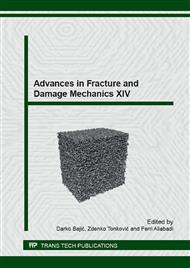p.253
p.257
p.261
p.265
p.269
p.273
p.277
p.281
p.285
Analytical Tool for the Preliminary Design of an Adhesively Bonded T Joint
Abstract:
Several different methodology for the study of adhesively bonded joints can be found in literature. However, most of those methods are joint-specific. One of the most interesting joint case is the bonding between the skin and the stringer of an aeronautical panel. Unfortunately, this case is one of the less studied, due to the complexity of the load conditions. In this paper, the problem of the skin stringer debonding under a T-pull load condition is analyzed. The analysis is performed by means of the methodology developed by Bigwood and Crocombe, that differs from other bonding technique because it is not joint-specific. Indeed, this method allows to solve any type of joints for which it is possible to specify the end loading values on every adherends’ sides. The results, in terms of peel and shear stress, are compared with the ones obtained via finite element methods, in order to validate the results for the specific load case considered.
Info:
Periodical:
Pages:
285-288
Citation:
Online since:
September 2015
Authors:
Price:
Сopyright:
© 2016 Trans Tech Publications Ltd. All Rights Reserved
Share:
Citation:


